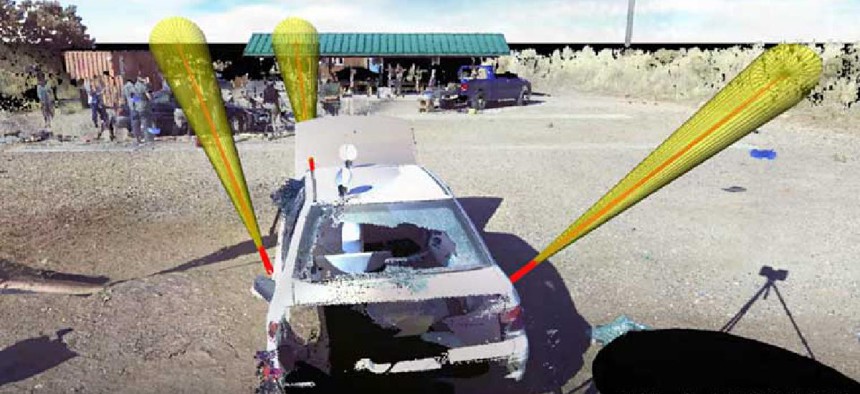3D scanner speeds police investigations

The scanner captures more than 900,000 data points per second that can be used to create 3D images of a crime or accident scene.
The Kearney, Neb., Police Department is saving time and improving the accuracy of crime scene investigations with the help of a 3D scanner. The device uses a laser to quickly take thousands of measurements that can be used to create a 3D model of the area.
Before the department bought the scanner, it took at least four officers four hours to document a scene. With the scanner, only two or three officers are needed, and they can collect all the information they need in significantly less time, Lt. Mike Young said.
“We’re collecting so much more data now in a 3D image," he added. "It’s like you can take the jury to the scene without leaving the courtroom.”
Historically, the department relied on manual data-recording devices such as tape measures, cameras, drawings and a total station, a surveying instrument that can measure angles but only in daylight. Now with a few clicks of the 3D scanner’s start button, officers can record a scene and move on. After traffic incidents, for example, that means returning roads to safety more quickly for officers and the public.
“It’s basically load and go,” Young said of the Faro Focus 3D X 330 Laser Scanner. Before, several officers took measurements of what they thought was important, "but with the Faro 3D scanner, you get absolutely everything. Even if [they] don’t think it’s important at the time," officers can go through the data and find details they might have missed.
The scanner captures more than 900,000 points per second, compared to the hundred or so that total-station equipment can collect, and it takes a fraction of the time, said Sunita Voleppe, senior product marketing manager for public safety at Faro. Plus, the scanner leaves less room for error by ensuring accuracy within a millimeter.
“It’s almost, if you can imagine, like painting a room,” Voleppe said. “Whatever this laser is touching, it’s capturing the data of it, [and] it can work in light or pitch black.”
“It sends an infrared laser beam to the center of a rotating mirror, and then the mirror will deflect the laser beam to a vertical location around the environment being scanned,” said Jennifer Faumuina, an agent at the Utah Department of Public Safety’s State Bureau of Investigation. “So basically the scanner can scan 360 degrees horizontally, and it can scan 300 degrees vertically.”
It can scan only 300 degrees vertically because it’s on a tripod, but to get a complete picture, officers can simply move the scanner, Young said. “Each scan location creates a piece of the puzzle,” he added.
Those puzzle pieces create a point cloud -- a set of data points in space. The data is automatically stored on an SD card that officers can remove from the scanner and insert into a computer. “That becomes a piece of evidence that they can track and handle,” Voleppe said.
Officers use Faro's Scene software to stitch point clouds together and create 3D images. They can then re-create scenes, measure and analyze blood spatter, and estimate trajectories -- all of which saves time, Faumuina said.
For example, “we can determine an area of convergence -- where the blood came from,” she said. “Without the scanner, we would have to be on the scene for hours on end doing the straining, [or patterning], ourselves.”
Faro Zone 3D software lets users move between 2D and 3D environments and integrates with images from other devices, such as drones. That approach facilitates reconstruction and analysis, Voleppe said, adding that the Faro Zone 3D 2018 update released in February incorporates virtual reality so that officers put themselves back at the scene.
The Faro Focus 3D starts at about $35,000, Voleppe said. Utah paid $40,000 to $50,000 for each of its scanners, Faumuina said, while the Kearney Police Department, which is colocated with the Buffalo County Sheriff’s Office, bought its scanner in 2015 for about $60,000 and spent another $40,000 on software, training and accessories such as extra batteries and a tripod. Annual costs for hardware and software maintenance amount to about $6,780.
The investment is worth it, Young said. “It’s a very valuable tool for law enforcement and can be used in so many different applications,” he added.
NEXT STORY: DARPA explores underground mapping





